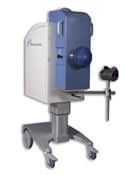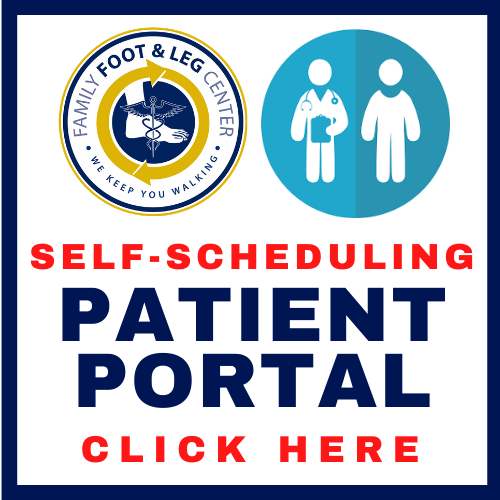Shockwave Therapy for Heel Pain (ESWT)
That's right, no hospital, no operating room, no surgical blades, no bandages, no stitches, no PAIN!!
Shockwave therapy involves resting your heel on a machine that pounds high energy sound waves into your heel through the skin. These 'sound waves' penetrate the soft tissue structures and bone in your heel and break up some of the scar tissue that causes your discomfort. The special products in your body that heal tissue are attracted to the shockwaves, and a healing response occurs over time!
88% of patients were extremely satisfied after the procedure, 84% of patients had an improvement in heel pain, and ALL patients returned their regular activities in less than 4 weeks!
Heel pain is a common complaint among the patients presenting and treated at Family Foot & Leg Center, particularly in the active population! Many patients, young and old, are competitive and/or leisurely tennis and golf players. These individuals typically complain of pain in the heel(s) most intense with the first few steps taken during the competition that ‘eases up’ as the game goes on. Sometimes the aching pain is felt in the arches, or even in the back of the heel. Eventually, the pain becomes aggravating enough that it is felt with every step attempting to return a serve, or with every long drive down the fairway.
When arch supports, custom orthotics, and cortisone injections fail, that is when we introduce shockwave therapy!
So….you’re wondering what the recovery process is after shock wave therapy?? The procedure takes about ½ hour per foot, in the office. Patients walk in, have the procedure, and walk out with a walking boot worn for an unspecified time period at your doctor’s discretion, depending upon the origin of your heel pain (minimum of 24 hours, maximum of 2 weeks).
Patients report NO pain during the procedure, and mild tenderness after the procedure for approximately 48-72 hours. You can walk, you can drive, you can go to the grocery store, sunbathe & swim, and go to dinner the evening of the procedure! Again, no hospitals, no operating room, no surgical blades, no bandages, no stitches, NO PAIN!!
How many treatments?
The number of treatments is dependent upon the type of shockwave therapy recommended for you, as well as your personal schedule and flexibility. To sum things up, there are two types of shockwave therapy—high energy and low energy.
High energy shockwave therapy requires one treatment, and the sound waves are of a higher frequency level. Low energy is one treatment weekly for 5 weeks, and the sound waves are of a lower frequency level. Our patients respond positively to both high and low energy shock wave therapy.
What are the disadvantages?
Unfortunately the majority of insurance companies do not cover the procedure despite shockwave’s impressive beneficial results in the medical literature. Therefore, shockwave therapy is an out-of-pocket expense. The medical community is hopeful that shockwave therapy will be compensable by insurance companies in the near future.
Why should I choose Shockwave therapy over a surgical procedure?
Because shockwave therapy has been found to be equally beneficial to an open surgical procedure, without the risks that open surgeries introduce (pronounced pain, swelling, infection, & the need for another surgery/revision).
The plantar fascia is a band of connective tissue on the plantar surface of the heel that plays a large role in maintaining the normal architecture of one's foot. Plantar fasciitis is a common clinical condition caused by overuse or injury of the plantar fascia and is defined as traction degeneration of the plantar fascial band at its origin on the medial tubercle of the calcaneus. Inflammation, fibrosis, and decreased vascularization of the fascia occur, causing symptoms of heel pain. Other symptoms that may occur include burning in the sole of the foot, recurring foot pain that is especially aching in the morning or after sitting, or heel pain after beginning a new exercise routine.
What causes plantar fasciitis?
There are a number of predisposing factors, including foot pronation, obesity, poor fitting shoes, minor trauma, occupational risks and change in exercise program. Although everyone is at risk, plantar fasciitis is most commonly found in athletes, runners, overweight individuals, or those who are required to stand on hard surfaces for prolonged periods of time. Although approximately 2,000,000 Americans suffer from plantar fasciitis ESWT is an appropriate treatment option in approximately 5 to 10% of those cases, as the remainder of the cases can be adequately addressed with more conservative therapies.Who should receive ESWT for plantar fasciitis?
Prior to undergoing ESWT treatment, the patient must have been diagnosed with chronic plantar fasciitis for at least six months. Only after the patient's symptoms fail to respond to three conservative treatments should ESWT be administered. Conservative treatments include rest, physical therapy, heel cushions, non-steroidal anti-inflammatory drugs (ibuprofen, acetaminophen, etc), cortisone injections, taping, orthotics, shoe modifications, night splinting and casting. In years past, surgical intervention for chronic plantar fasciitis was required when these other treatments had failed. Today, ESWT is available as an alternative, non-invasive treatment option.
Who should not receive ESWT treatment for plantar fasciitis?
Your health history should be reviewed with your doctor to see if this treatment is appropriate for you. ESWT is not recommended for patients with certain conditions. Patients with pacemakers and patients taking medications that may prolong or interfere with blood clotting (coumadin) are not candidates for ESWT. Also, children or pregnant women are not considered appropriate candidates for ESWT. ESWT is not appropriate for individuals suffering from acute plantar fasciitis.
What are the side effects of ESWT?
Compared to surgery, ESWT has fewer side effects and a much shorter recovery time. The most common patient complaint is some minor pain or discomfort during and after treatment. Other side effects might include minor skin bruising, reddening, or swelling of the treated area. However, these possible occurrences usually resolve within a few days. The risks associated with surgery and general anesthesia are eliminated.
Is ESWT covered by insurance?
Unfortunately, ESWT is not covered by any insurance company. Despite numerous favorable articles about the positives of ESWT for chronic musculoskeletal pain problems this remains an uncovered service. We at the Family Foot and Leg Center not only has the high energy ESWT machine that is shared with the regional professional team, but also a low energy machine that is more affordable but requires up to 5 treatments at weekly intervals, package pricing available. Ask your treating physician if this will be of benefit to you.
Workers compensation and auto insurers may over this as they value this technology as a way to avoid more expensive surgery.
What should I expect before, during, after ESWT treatment?
An initial consultation to rule out other causes of your Heel or Achilles pain will be done. During the visit a digital x-ray series is taken to ensure that are no other problems are causing your pain such as a stress fracture, fracture, bone tumors, etc. At times a soft tissue ultrasound will be done to assess the exact location and measure the extent of inflammation and possible tears.During the procedure:
- Low energy ESWT: expect to spend about 10 minutes getting
the treatment, no anesthesia is required but for some patients the
initial treatment can be uncomfortable. Local anesthesia can be
administered in such cases, but only 1% of our patients requires such.
If you are in the 1% usually by the third treatment your condition
(Plantar Fasciitis or Achilles Tendonitis) would have improved enough to
not require anymore anesthesia. The low ESWT procedure causes
anesthesia via negative feedback and desensitize the treated area.
Remember that 5 treatments are required for the low energy at 4-7 days
apart.
- High energy ESWT: a local / regional anesthesia will be administered then after 5 minutes the procedure is started. Expect 15-20 minutes for treatment but you will be totally anesthetized. Usually one treatment is all that is needed, but on a rare occasion a second application would be required at 6 months.
You should feel 90% - 100% resolution by 5 months.
For Achilles tendonosis / tendonitis we have been able to avoid surgery on a majority of our patients even those with large heel spurs! The spurs remains but the pain is gone, thus, no further intervention is required. We have had patients that were scheduled for surgery at another facility but after ESWT the pain fully resolved.
For Plantar Fasciitis / Plantar Fasciosis: in case of a tight plantar fascia that just won't give up, a simple medial plantar fascia lengthening can be done in the office via our minimally invasive technique. Remember, it is not the spur that is causing your pain it is the inflammation of the tissue that is causing your pain.
ESWT
Shockwave Therapy for Heel Pain
NO HOSPITAL, NO OPERATING ROOM,
NO SURGICAL BLADES, NO BANDAGES,
NO STITCHES, NO PAIN!!! START HEALING NOW!
Call Today: 239 430 3668 (FOOT)
Self Service # (239) 420-7170
Fax: 239 692 9436
Family Foot & Leg Center now has 9 convenient locations throughout Collier, Lee, Charlotte, and Sarasota Counties
- DOWNTOWN NAPLES - Brennan Bldg, 730 Goodlette Rd, Suite 102
- SE NAPLES - Mustang Center, 12250 Tamiami East, Suite 101, Naples FL
- NORTH NAPLES - 840 111 Ave. North, Suite#3, Naples FL
- ESTERO - Natoli Plaza, 21401 Corkscrew Village Lane, Suite 4
- CAPE CORAL - 530 S.E. 16th Place, Suite A
- FT MYERS INTERNATIONAL BLVD - 6846 International Center Blvd. Suite B
- FT MYERS COLONIAL BLVD - 1645 Colonial Blvd
- PORT CHARLOTTE - 3161 Harbor Blvd Suite B
- SARASOTA - 3110 Fruitville Commons Blvd Suite 102

